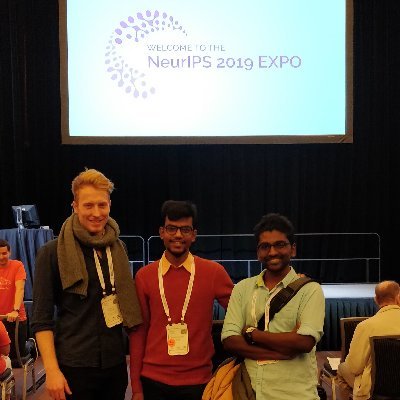
mihail.todorov.muc
@MihailMuc
Followers
118
Following
183
Media
3
Statuses
154
We discovered that the skull bone marrow has direct connections to brain surface & mirrors brain inflammation, making it a new site for diagnosing & monitoring brain pathologies. Kolabas…Ertürk, Cell: https://t.co/o8jTfgI1Ms
https://t.co/2sPQra6sHZ
https://t.co/NWNp39efaX
6
43
152
We have developed MouseMapper AI, a deep learning ensemble for the analysis of whole-body systems, including the nervous and immune systems, to map disease/drug perturbations tissue by tissue, organ by organ, at the cellular level in 3D. MouseMapper uncovered obesity-induced
13
133
578
Excited to share our latest work with Denali Therapeutics as Deep Piction. Using our proprietary clearing & imaging, we’ve mapped the full targeting profile of brain-penetrating transport vehicles (ATVs) in both whole mouse bodies and monkey brains. https://t.co/TAhpX5becT
2
16
80
See our recent @NatureBiotech study SCP-Nano in flow! Mapping LNPs, AAVs, and DNA nanostructures to track targeting & unseen toxicity before clinical trials 🤩. Already >190K access, the most in recent years! 👇🏼 https://t.co/1YniGZqwYw
1
35
141
LNP/mRNA therapeutics and AAV-based approaches require cell-level precision to achieve success without significant toxicity to other cells. To enable this, we now introduce SCP-Nano🤗 in @NatureBiotech: an AI-based technology for precision nanotechnology. https://t.co/1YniGZr4O4
11
72
221
SCP-Nano: Advancing Precision Medicine with Nanocarrier Visualization How can life-saving therapies reach their target cells without harmful side effects? 👉 https://t.co/8b2ONpOGNE 💡Researchers at #HelmholtzMunich, @LMU_Muenchen, and @TU_Muenchen have developed SCP-Nano
0
10
19
Our new study shows that SARS-CoV-2 spike protein accumulates & persists in the body for years after infection, especially in the skull-meninges-brain axis, potentially driving long COVID. mRNA vaccines help but cannot stop it🔬🧠🦠🧵👇@cellhostmicrobe
https://t.co/IEGx7HIrXf
477
3K
6K
ErtürkLab is now on BlueSky! 🦋 We’re exploring new spaces for science communication. Follow us for our updates on AI & tissue clearing-driven whole body imaging for cellular-level disease research: https://t.co/9SWCV5TNj7
1
7
69
Thrilled to announce that I will be starting as an Assistant Professor at Cornell University in February! #MICCAI #miccai2024
https://t.co/0kStRv6JWY
linkedin.com
Thrilled to announce that I will be starting as an Assistant Professor at Cornell University in February! A huge thank you to all my mentors, for their guidance, and to my incredible colleagues and...
11
9
132
Imagine seeing a disease's impact on every cell in the body. Now, you can! We introduce MouseMapper, an AI tool to reveal system-wide disease perturbations. MouseMapper showed obesity-induced changes in facial nerves & body-wide inflammation 👉🏼🧵 https://t.co/2sPQra70xx
18
225
637
What if we could map every cell in the body, revealing its location and molecular identity? In this @NatureMethods perspective, we discuss the new era of 3D-omics by tissue clearing and AI, called Deep 3D Histology: https://t.co/iXRJ5GrpV3 PDF: https://t.co/fiR3wBonDe 🧵👇🏼
3
90
355
The July issue is live today! https://t.co/WkJdk9BPCS The beautiful cover comes from the @erturklab and shows c-Fos+ neuronal mapping in whole mouse brains. See paper: https://t.co/dOaFfRzyLj
4
37
118
🎉We're thrilled to announce the #MICCAI2024 SELMA challenge on self-supervised learning for 3D light-sheet microscopy image segmentation. Explore our dataset, which contains 3D light-sheet microscopy images of various labeled structures and is possibly the largest 3D microscopy
2
21
68
New preprint on cortex folding, by an international team around Ruediger Klein:
biorxiv.org
Folding of the mammalian cerebral cortex into sulcal fissures and gyral peaks is the result of complex processes that are incompletely understood. Previously we showed that genetic deletion of...
1
5
16
DELiVR, is a deep-learning pipeline for whole-brain cell mapping, which is trained on reference annotations generated in a virtual reality environment. https://t.co/rhx5iOKAhZ
#NBThighlight
nature.com
Nature Methods - Generating training data for training deep-learning-based tools is time consuming. The DELiVR pipeline facilitates this process as demonstrated in this study on detecting c-Fos+...
1
29
94
The DELiVR pipeline enables deep learning-based analysis of neuronal activity or other processes in the brain after tissue clearing and light-sheet imaging. DELiVR’s virtual reality approach facilitates the generation of training data for deep learning. https://t.co/dOaFfRzyLj
6
25
71
Amazing case of combining virtual reality for scientific and broad use! Honored to be part of this effort :)
Very excited to share that our DELiVR method is now open access published @NatureMethods. We created a simple, brain-wide cell analysis deep learning tool, no coding needed! Fiji Plugin makes it accessible to all. https://t.co/qjFk3p5aba by @Dorie00 @Rami96614090 @moritz_negwer
0
1
7
The April issue is live https://t.co/wVzwnybjTU Our cover shows an image of a whole mouse body with depth color-coding of a neuronal marker. Mai et al. present wildDISCO, a method for whole-body imaging compatible with standard IgG antibody labeling https://t.co/POOiYZVyGS
2
66
271
Great opportunity to collaborate! Check out the interactive database at
I am super excited to share our paper with @Judit_GonzalezG on proteomic profiling of BECs during aging, just out at @NatureAging ! Big thanks for the contribution of the whole author team!
0
2
8
Important study. Our work in bioRxiv provides the molecular underpinnings - how the SARS-CoV-2 spike protein induces vascular damage and inflammation in the skull-meninges-brain axis.
biorxiv.org
Coronavirus disease 2019 (COVID-19), caused by the severe acute respiratory syndrome coronavirus type 2 (SARS-CoV-2), has been associated mainly with a range of neurological symptoms, including brain...
Leaky blood-brain barrier in long-COVID associated brain fog This study confirms everything I have seen in the microscope over the last few years. They use a technique called dynamic contrast-enhanced magnetic resonance imaging (DCE-MRI), an imaging technique that can measure
1
21
89










